
USS Vancouver (LPD-2) was a Raleigh-class amphibious transport dock, named after the city of Vancouver, Washington, which was in turn named after the famous north-west explorer George Vancouver. Vancouver's was commissioned 11 May 1963 and served during the Vietnam War and 1991 Gulf War. She was decommissioned 27 March 1992, placed in reserve and stricken 8 April 1997. Title was transferred to the United States Maritime Administration 29 November 2001. Vancouver was towed for scrapping in Brownsville, Texas, in April 2013.
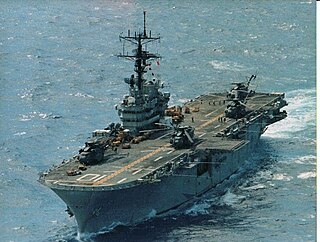
USS Tripoli (LPH-10), an Iwo Jima-class amphibious assault ship, was laid down on 15 June 1964 at Pascagoula, Mississippi, by the Ingalls Shipbuilding Corporation; launched on 31 July 1965; sponsored by Jane Cates, the wife of General Clifton B. Cates, former Commandant of the Marine Corps; and commissioned on 6 August 1966 at the Philadelphia Naval Shipyard. Tripoli was the second US Navy ship named for the Battle of Derna in 1805. It was the decisive victory of a mercenary army led by a detachment of US Marines and US Army soldiers against the forces of Tripoli during the First Barbary War and was the first recorded land battle of the United States fought overseas.

Operation Deckhouse Five was a United States Marine Corps (USMC) and Republic of Vietnam Marine Corps operation that took place from 6–15 January 1967 in the Mekong Delta, during the Vietnam War. "The ten-day sweep," reported the AP from its daily military roundup from Saigon, "proved unproductive."

The 3rd Marine Division is a division of the United States Marine Corps based at Camp Courtney, Marine Corps Base Camp Smedley D. Butler in Okinawa, Japan. It is one of three active duty infantry divisions in the Marine Corps and together with the 1st Marine Aircraft Wing (1stMAW) and the 3rd Marine Logistics Group forms the III Marine Expeditionary Force. The division was first formed during World War II and saw four years of continuous combat in the Vietnam War. Today, elements of the 3rd Marine Division are continuously forward deployed and forward postured to carry out the US Government's mission of a Free and Open Indo-Pacific in conjunction with its sister services.

Marine Aircraft Group 16 is a United States Marine Corps aviation unit based at Marine Corps Air Station Miramar that is currently composed of four V-22 Osprey squadrons, four CH-53 Super Stallion squadrons, one Personnel Support Detachment, and an aviation logistics squadron. The group falls under the command of the 3rd Marine Aircraft Wing and the I Marine Expeditionary Force.

2nd Battalion, 4th Marines (2/4) is an infantry battalion of the United States Marine Corps. The battalion, nicknamed the Magnificent Bastards from the Vietnam War, is based out of Marine Corps Base Camp Pendleton, California and is a part of the 4th Marine Regiment and 1st Marine Division.
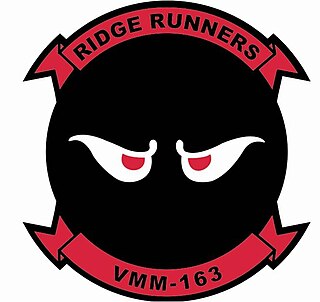
Marine Medium Tiltrotor Squadron 163 (VMM-163) is a United States Marine Corps helicopter squadron consisting of MV-22 Osprey transport tiltrotors. The squadron, known as "Evil Eyes", is based at Marine Corps Air Station Miramar, California and falls under the command of Marine Aircraft Group 16 (MAG-16) and the 3rd Marine Aircraft Wing.

Da Nang Air Base (1930s–1975) was a French Air Force and later Republic of Vietnam Air Force (RVNAF) facility located in the city of Da Nang, Vietnam. During the Vietnam War (1959–1975), it was a major base with United States Army, United States Air Force (USAF), and United States Marine Corps (USMC) units stationed there. Air Vietnam also used the facility from 1951 to 1975 for civilian domestic and international flights within Southeast Asia.
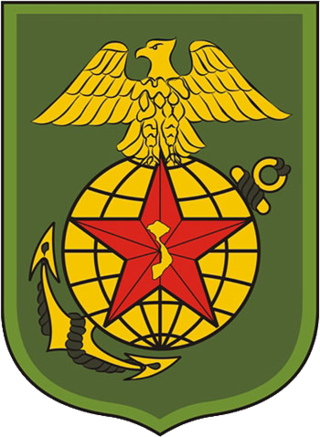
The Republic of Vietnam Marine Division was part of the armed forces of South Vietnam. It was established by Ngo Dinh Diem in 1954 when he was Prime Minister of the State of Vietnam, which became the Republic of Vietnam in 1955. The longest-serving commander was Lieutenant General Le Nguyen Khang. In 1969, the VNMC had a strength of 9,300, 15,000 by 1973, and 20,000 by 1975.
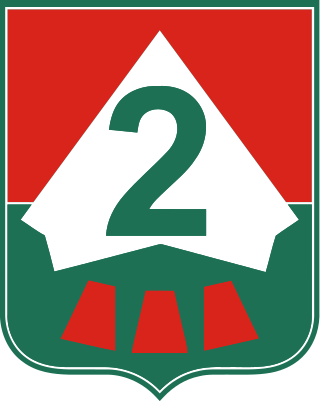
The 2nd Division was a division of the Army of the Republic of Vietnam (ARVN)—the army of the nation state of South Vietnam that existed from 1955 to 1975. It was part of I Corps that oversaw the northernmost region of South Vietnam.
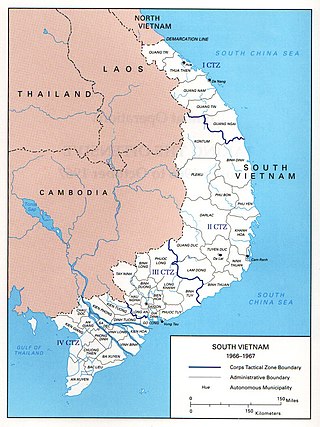
At the beginning of 1966, the number of U.S. military personnel in South Vietnam totaled 184,300. South Vietnamese military forces totaled 514,000 including the army (ARVN) and the Regional Force and Popular Force militias. The North Vietnamese People's Army of Vietnam (PAVN) numbered 400,000, most still in North Vietnam. 50,000 PAVN cadre and soldiers infiltrated South Vietnam during 1965. Group 559, charged with transporting supplies down the Ho Chi Minh Trail to supply PAVN troops in both South Vietnam and Laos, numbered 24,400 personnel. The U.S. estimated the number of Viet Cong (VC) and PAVN soldiers in South Vietnam at nearly 280,000 by June 1966, including part-time guerrillas. A pause in the bombing of North Vietnam by U.S. warplanes had been announced by President Johnson on 24 December and remained in effect.

Marine Medium Tiltrotor Squadron 363 (VMM-363) is a United States Marine Corps tiltrotor squadron consisting of MV-22B Ospreys. The squadron, known as the "Lucky Red Lions", is based at MCB Hawaii and falls under the command of Marine Aircraft Group 24 (MAG-24) and the 1st Marine Aircraft Wing.

Operation Double Eagle was a US Marine Corps and Army of the Republic of Vietnam (ARVN) operation that took place in southern Quảng Ngãi Province, lasting from 28 January to 17 February 1966, during the Vietnam War. The operation was mounted in conjunction with Operation Masher in northern Bình Định Province. The operation was inconclusive as the People's Army of Vietnam (PAVN) and the Vietcong (VC) had largely slipped away.
Hill 327 is a former U.S. Marine Corps (USMC), U.S. Army and Army of the Republic of Vietnam (ARVN) base southwest of Da Nang in central Vietnam. The base was established on a ridgeline 4 km west of Da Nang Air Base.
The 1st Battalion, 26th Marines (1/26) is an inactive infantry battalion of the United States Marine Corps. They were part of the 26th Marine Regiment and 5th Marine Division and fought during the Battle of Iwo Jima in World War II. They were activated again for the Vietnam War but were deactivated after the war and remain inactive today.
Operation Deckhouse IV was an operation conducted by the Special Landing Force (SLF) Battalion Landing Team (BLT) of 1st Battalion, 26th Marines in the eastern Demilitarized Zone (DMZ), lasting from 15 to 18 September 1966.
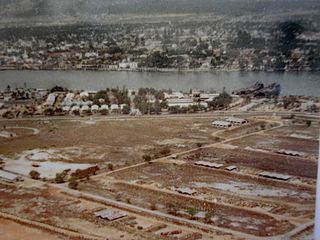
Camp Horn is a former United States Marine Corps and United States Army base located in Danang, Vietnam.

Operation Badger Tooth was a search and destroy mission in the Street Without Joy area of Quảng Trị Province carried out by the 3rd Battalion, 1st Marines. Launched on 26 December 1967 the operation ended on 2 January 1968. The Marines reported the People's Army of Vietnam (PAVN) lost 131+ killed, while US casualties were 48 killed.
Operation Houston was a security operation in the Vietnam War conducted by the United States Marine Corps’ Task Force X-Ray to reopen and secure Route 1 between Da Nang and Phu Bai Combat Base that took place from 26 February to 12 September 1968.

The Battle of the Mỹ Chánh Line took place from 5 May to 26 June 1972 during the People’s Army of Vietnam (PAVN)'s Easter Offensive of the Vietnam War. South Vietnamese forces, principally the Marine Division, with extensive fire and logistics support from United States forces, succeeded in stopping the PAVN advance northwest of Huế and launched a series of spoiling attacks against PAVN units. The successful defense allowed South Vietnamese forces to build up strength and then establish jumping off positions for their counteroffensive to recapture Quảng Trị Province.



















